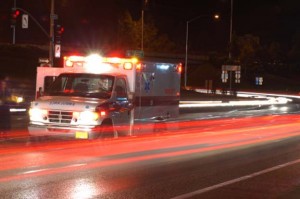Commercials for great deals on new cars are filling the airwaves and gas prices are rising on every corner, and those things can mean only one thing: Memorial Day is right around the corner.
For many that will mean traveling to picnics, soccer tournaments and trips to weekend vacation homes, but the National Safety Council is predicting it will be the deadliest holiday weekend in seven years. The advocacy group believes 439 people will die in auto accidents this weekend.
If true, it will be the highest numbers since 2009 when 462 people died. NSC officials estimate an additional 50,000 injuries during the extended holiday weekend.
Memorial Day also marks the unofficial start of summer, which always is a dangerous time on the roads. More than 9,570 people died on American roads in 2014 from May 24 and Aug. 31.
“As Americans gear up for the most carefree months of the year, we cannot take our safety for granted,” said Deborah A.P. Hersman, president and CEO of the National Safety Council.
(U.S. highway fatalities surge 8% in 2015. For details, Click Here.)
“Driving is one of the riskiest things we do every day. Engaging our defensive driving skills and staying alert can mean the difference between attending cookouts and family parties or spending the evening at the emergency room or worse.”
To help stay safe on the roads this summer, the Council recommends:
- Making sure every passenger buckles up every trip. The Council estimates 104 people could be saved this Memorial Day holiday if they buckle up.
- Designating an alcohol and drug-free driver or arranging alternate transportation.
- Getting plenty of sleep and taking regular breaks to avoid fatigue on long trips.
- Never using a cell phone behind the wheel, even hands-free.
- Staying engaged with your teens driving habits. An NSC survey found many parents are more inclined to loosen household driving rules during the summer.
- Learning about your vehicle’s safety systems and how to use them. Knowing the ins and outs of features such as adaptive cruise control, automatic emergency braking, blind spot warning systems and backup cameras.
The estimate comes as traffic fatalities continue to trend upwards. In February, the NSC released its preliminary estimates showing motor vehicle fatalities had increased 8% in 2015 compared to 2014 – the largest year-over-year percentage increase in 50 years.
(Click Here for details about the rise in pedestrian deaths in the U.S. last year.)
Part of that reason is that Americans are driving more than ever, logging a record 3.148 trillion miles behind the wheel, according to new data from the Federal Highway Administration. Exactly why Americans are driving more is unclear, however, FHA spokesman Doug Hecox told the Minneapolis Star Tribune earlier this year, “We just know there are more cars out there and they’re going farther.”
The council believes the spike in fatal car crashes is due in part to an improving economy with lower gas prices and lower unemployment rates. Certain crash factors, such as speeding and alcohol, are more common during the summer, too.
That combination has given rise to a 10% in pedestrian deaths. The Governors Highway Safety Association analyzed data for the first half of 2015 and based on those results came up with the double-digit increase in deaths compared with 2014 results.
“Pedestrian safety is clearly a growing problem across the country,” said Richard Retting of Sam Schwartz Consulting and co-author of the report.
“It is important to understand the data underlying these crashes so states and localities can apply the right mix of engineering, education and enforcement to counteract this troubling trend.”
(To see more about why car crashes are the No. 1 killer of teenagers, Click Here.)
Along with the increase in pedestrian fatalities, pedestrians now account for a larger share − about 15% of all motor vehicle crash-related deaths − compared with 11% a decade ago.



Perhaps time to lower speed limits as in 1985, which was touted at saving lives; and burning less oil. I would like to see a breakdown by vehicle class, especially motorcycle fatals. And a breakdown by the followiing variables: age, gender, sexuality, skin color, religion, occupation, education, time of day, day of week, county and state. Those statistics may show a trend for a specific target group. Then prevention, advertising dollars and enforcement of traffic laws could be better focused.